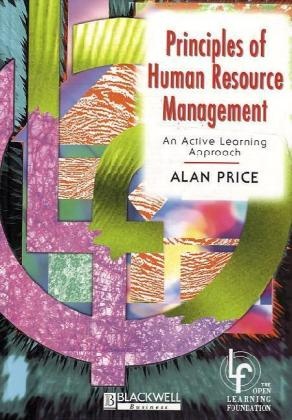Share
Fr. 127.00
Open Learning Foundation, Price, Alan Price
Principles of Human Resource Management - An Active Learning Approach
English · Hardback
Shipping usually within 3 to 5 weeks (title will be specially ordered)
Description
Principles of Human Resource Management is part of a major new national programme of texts and modules designed for undergraduate students following business studies degree courses. It provides 150 hours of high quality study designed to be used by students in a supported learning environment.
The module provides a comprehensive introduction to the development of human resource management and the changing nature of work. It also covers some of the key topics in the field, including equal opportunities, employee resourcing, employee relations, reward management and employee development.
Principles of Human Resource Management contains numerous activities, exercises and examples to develop an in-depth understanding of the subject. It is the most effective teaching and learning resource available at this level.
List of contents
Guide for Students XV.
Unit 1: Introduction to Human Resource: .
Management.
Introduction.
Objectives.
Part I: The Theoretical Basis of Human Resource: .
Management.
Introduction.
1.1 Defining HRM.
1.2 Origins.
1.3 The Driving Forces of Human Resource Management.
Summary.
Part II: HRM and Personnel Management: .
Introduction.
2.1 The Personnel Management Tradition.
2.2 Personnel Management and HRM.
2.3 Generalists and Specialists.
Summary.
Part III: Models and Theories of Human Resource Management: .
Introduction.
3.1 The Harvard Model.
3.2 The Michigan Model.
3.3 The Purpose of HRM.
3.4 Common Features of Human Resource Models.
Summary.
Unit Review Activity.
Unit Summary.
References.
Recommended Reading.
Answers to Unit Review Activity.
Unit 2: The Changing Nature of Work: .
Introduction.
Objectives.
Part I: Changing Types and Patterns of Work: .
Introduction.
1.1 Knowledge, Skills and The Job Market.
1.2 Flexibility.
1.3 The Flexible Firm.
Summary.
Part II: Alternative Staffing: .
Introduction.
2.1 Part-time Working.
2.2 Job Sharing.
2.3 Temporary and Contingent Employees.
Summary.
Part III: Trends in Work Organisation: .
Introduction.
3.1 Managing People in Flat and Distributed Organisations.
3.2 Management Through Networks.
3.3 Teleworking.
Summary.
Unit Review Activity.
Unit Summary.
References.
Recommended Reading.
Answers to Unit Review Activity.
Unit 3: Employment Resourcing: Planning and Recruitment: .
Introduction.
Objectives.
Part I: Planning and Forecasting: .
Introduction.
1.1 Human Resource Planning.
1.2 Turnover and Wastage.
1.3 Integrated Planning.
Summary.
Part II: Job Analysis: .
Introduction.
2.1 Collecting Job Information.
2.2 Analysing Job Information.
2.3 Job Descriptions and Personnel Specifications.
Summary.
Part III: Recruitment: .
Introduction.
3.1 Applicant Targeting.
3.2 Informal Versus Formal Recruiting.
Summary.
Unit Review Activity.
Unit Summary.
References.
Recommended Reading.
Answers to Unit Review Activity.
Unit 4: Employee Resourcing: Selection: .
Introduction.
Objectives.
Part I: Candidate Data and Screening: .
Introduction.
1.1 Aims of The Selection Process.
1.2 Job Applications.
1.3 Using Candidate Data.
1.4 Validity and Reliability of Selection Methods.
Summary.
Part II: Selection Interviews: .
Introduction.
2.1 Interviewing as a Selection Method.
2.2 Criticisms of Interviewing as a Method of Selection.
2.3 Structured Interviewing.
Summary.
Part III: Advanced Selection Methods: .
Introduction.
3.1 Psychometric Tests.
3.2 Work Samples and Assessment Centres.
3.3 Use of Different Selection Methods.
Summary.
Unit Summary.
References.
Recommended Reading.
Unit 5: Performance Management: .
Introduction.
Objectives.
Part I: Managing Performance: .
Introduction.
1.1 Performance Management Systems.
1.2 Foundations of Performance Assessment.
1.3 Performance Objectives.
Summary.
Part II: Measuring Performance: .
Introduction.
2.1 Traditional Appraisals.
2.2 Competence Approaches.
2.3 Assessing Organisations and Teams.
Summary.
Part III: The Consequences of Performance Management: .
Introduction.
3.1 Performance Feedback.
3.2 Performance Management and Pay.
3.3 Feedback and Human Resource Development.
Summary.
Unit Review Activity.
Unit Summary.
References.
Recommended Reading.
Answers to Unit Review Activity.
Unit 6: Equality of Opportunity: .
Introduction.
Objectives.
Part I: Equal Opportunities in Context: .
Introduction.
1.1 Discrimination and Inequality.
1.2 Ethical and Social Dimensions.
1.3 Management of Diversity.
Summary.
Part II: Race, Ethnicity and Gender: .
Introduction.
About the author
Formerly Principal Lecturer in Human Resource Management at Thames Valley University School of Business, Alan Price is the author of several books and editor of The Internet Guide to Human Resource Management.
Summary
Principles of Human Resource Management is part of a major new national programme of texts and modules designed for undergraduate students following business studies degree courses. It provides 150 hours of high quality study designed to be used by students in a supported learning environment.
Product details
| Authors | Open Learning Foundation, Price, Alan Price |
| Publisher | Wiley & Sons |
| Languages | English |
| Product format | Hardback |
| Released | 01.01.2009 |
| EAN | 9780631201786 |
| ISBN | 978-0-631-20178-6 |
| No. of pages | 466 |
| Weight | 800 g |
| Series |
In Charge |
| Subject |
Social sciences, law, business
> Business
> Management
|
Customer reviews
No reviews have been written for this item yet. Write the first review and be helpful to other users when they decide on a purchase.
Write a review
Thumbs up or thumbs down? Write your own review.

